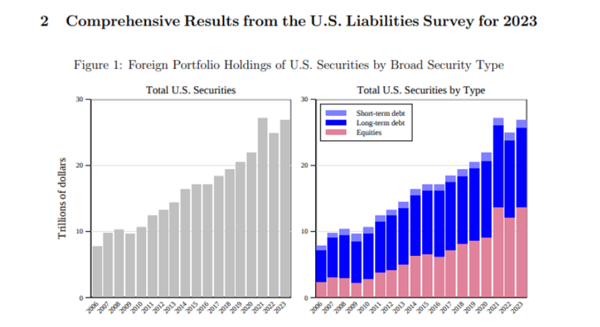The One Big Beautiful Bill (OBBB) recently passed the House, and it’s now awaiting Senate scrutiny.
Most analyst coverage focused on the bill piling up further government spending on existing deficits, but by far the most important part of the OBBB was deep down in the docs – specifically, in section 899.
Section 899 is the first step towards tariffs on money as a complement to tariffs on goods.
So: what did the Trump administration include in section 899 – the first step towards Tariffs on Money?
1) What is it -> Section 899 also known as the ‘’revenge bill’’ imposes taxes on passive income (e.g. dividends) deriving from foreign ownership of US assets on countries that have enacted ‘’unfair foreign taxes’’ on the US (read: digital service tax or minimum corporate taxes like Canada, Europe and others);
2) Who gets charged -> For a country to be subject to such taxes, it’s enough for the Treasury department to include them in a specific list of DFC – discriminatory foreign countries;
3) The applicable entities -> They include governments, individuals, and corporations – pretty much every investor, including sovereign wealth funds and foreign central banks;
4) How high is the tax rate -> Section 899 generally increases the current U.S. tax rates imposed on applicable entities by 5% in the first year following enactment, increased by an additional 5% for each subsequent year, with the increases capped at 20% above the statutory rate. This is key: for section 899 to apply, there must already be an applicable tax rate (before or after tax treaties) to push up.
5) When could it kick in -> Assuming the OBBB is enacted before October 2025, the Section 899 will take effect as per January 1st 2026
Tariffs on goods have been estimated to bring in about USD ~200/250 bn/year for the US government.
The impact of a moderate Tariffs on Money would be potentially in the USD 100-150 bn/year too.
But that requires a key change: the repeal of the Portfolio Interest Exemption (PIE).
PIE exempts foreign investors from incurring in any withholding taxes when they buy US Treasuries, and Section 899 only applies a surcharge tax to existing tax rates for foreign investors – which PIE puts at zero for foreign ownership of US Treasuries.
Unless the portfolio interest exemption (PIE) is repealed, Section 899 would only apply to dividends on equities held by foreign institutions – bringing in only a few $ billions/year to the Trump administration.
This clause in the Big Beautiful Bill clearly explains that (without a PIE repeal) the Section 899 wouldn’t apply to ‘’portfolio interest’’ – basically coupons on Treasuries held by foreigners:
In its current format, Section 899 would send a worrying signal to foreign investors but its immediate impact would be quite limited.
Foreign investors own $13 trillion worth of US stocks, but Section 899 would apply a limited surcharge tax on dividends only and hence cause limited damage. After all, investors own US stocks for capital appreciation much more than they do to collect dividends.
But a repeal of PIE would bring Treasury coupons under the 30% withholding tax regime, and after applying tax treaties but overlaying the Section 899 tax surcharges we’d be looking at a big impact.
Coupons deriving from $15+ trillion in US Treasuries owned abroad would incur 20%+ total tax rates, but to get there the Trump administration would have to repeal PIE:
I can’t see any rationale behind including Section 899 in the Big Beautiful Bill to only collect 2-3bn/year by taxing dividends on stocks only.
If Tariffs on Money needs to be part of the revenue-raising machine for the Trump administration, they need to go along with a repeal of PIE.
A potential plan could look like this:
1) Pass the Big Beautiful Bill through the Senate possibly in July, but anyway before the August recess;
2) Work in parallel on a repeal of PIE – sending a strong signal to ‘’discriminatory countries’’;
3) To soothe bond market jitters, accelerate the SLR reform to incentivize US banks to buy Treasuries
Bessent has already indicated Q3 as the likely date to accelerate the efforts behind the SLR reform, and such a timeline could be more than a mere coincidence.
From a market impact standpoint, there are two paths ahead of us:
A) Section 899 without PIE repeal: a marginally weaker
B) Section 899 + PIE repeal: a large USD down + bond yields up move
Even without PIE repeal, Section 899 raises red flags amongst foreign institutional investors.
Using my beloved Canadian pension fund reference, if you were the CIO or the Investment Committee sitting on a 50%+ allocation to US assets and you see Section 899 enacted – what would you do?
You’d at least passively reinvest your maturities away from the US and hedge your material USD risk.
And if you were to see concrete talks about a Portfolio Interest Exemption repeal hitting you heavily on your Treasuries coupons – what would you do?
This would be akin to ‘’selective Fed cuts’’ only applying to you: a 20% total tax rate on a US Treasury paying a 5% coupon would be akin to a 100 bps reduction in interest rate earned.
Add a weakening USD to the picture, and you’d have to rush to hedge your USD exposure alongside considering domestic bonds or other bond markets (Europe?) as an alternative.
To conclude: while investors had already many reasons to be short USD, they are now looking at 899 reasons more.
This was it for today, thanks for reading! Feel free to share this with a friend or colleague.
***
This article was originally published on The Macro Compass. Come join this vibrant community of macro investors, asset allocators and hedge funds – check out which subscription tier suits you the most using this link.
